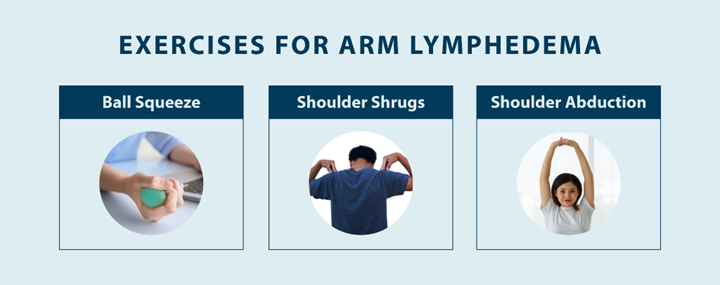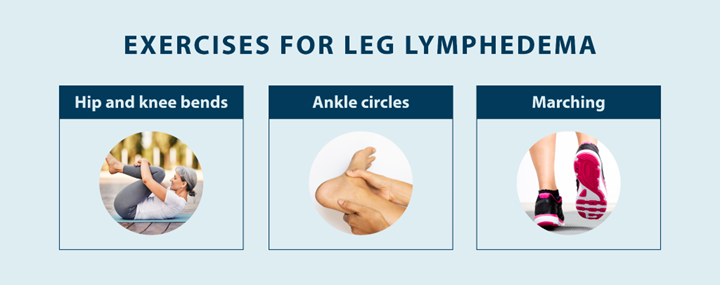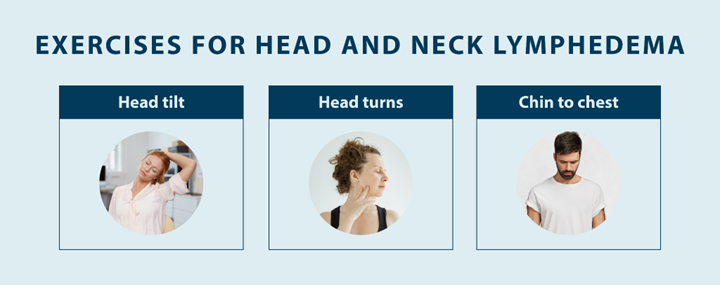Lymphedema and Weight Loss
Living with lymphedema while trying to manage your weight can feel overwhelming, but understanding the connection between lymphedema and weight loss can help you develop effective strategies for both conditions.
Read More

Lymphedema exercises can help reduce some of the swelling and discomfort that lymphedema causes. These exercises are easy to do at home, and they’re an important part of managing your symptoms when living with lymphedema. By spending a few minutes each day performing these exercises, you can manage your symptoms to help regain your quality of life. To learn more about exercises for lymphedema and how to do them, read our guide below to get started.
What Is Lymphedema?
How Does Exercise Help Lymphedema?
Is it Safe to Exercise with Lymphedema?
Exercises for Arm Lymphedema
Exercises for Leg Lymphedema
Exercises for Head and Neck Lymphedema
FAQs: Lymphedema Exercises
Wrapping Up: Managing Lymphedema With Exercise
Lymphedema is a medical condition caused by a disruption to the lymphatic system, which leads to a buildup of fluid called lymph in the body. Lymphedema can occur as a result of damage to a lymph node, damage to a lymph node or vessel, or other lymph system problems.1
When your lymphatic system is working properly, fluid is filtered through the lymph nodes, then transported by way of the lymph vessels to empty back into the bloodstream which helps manage fluid levels in the body. In patients with lymphedema, this fluid can build up in the soft tissues of the body rather than draining back into the bloodstream, resulting in swelling in the legs, feet, groin, arms, hands, chest, head, and/or neck.
The primary goal of lymphedema treatment and management is to reduce the buildup of fluid that causes swelling and other symptoms lymphedema patients may experience. It’s also important to take steps to lower your risk of infections, which may include good hygiene, proper nail care, and avoiding tight or restrictive clothing.
Because lymphedema causes swelling that may lead to numerous symptoms, reducing that swelling should be your first focus. Exercise is one of the best ways to get relief from lymphedema, and there are specific lymphedema leg exercises and arm exercises that can be performed by your therapist or yourself at home. But how exactly does exercise help lymphedema, and how does exercise fit into a typical lymphedema treatment plan?
Exercise stimulates the muscles in your body, which can help increase the flow of lymph fluid away from swollen areas. Regular exercise also helps you maintain a healthy weight, which can reduce the severity of swelling and other lymphedema symptoms.2 Your doctor may recommend making changes to your diet and exercising regularly as part of your lymphedema management plan.

It’s also important to consider the fact that a sedentary lifestyle is a significant risk factor for lymphedema, so making sure you’re active is critical. However, you don’t need a gym membership or expensive at-home equipment like a treadmill to manage your lymphedema symptoms. You can talk to your doctor or lymphedema specialist about safely incorporating walking, swimming, and other light physical activity into your daily routine.
In most cases, yes, it’s safe to exercise with lymphedema as long as that exercise isn’t causing you pain or discomfort.2 Your therapist may recommend starting out with light activities and working your way up slowly. Even if you start slow, exercising can help with lymphedema symptoms by promoting the circulation of fluids throughout your body.
There are a handful of lymphedema arm exercises that can help with upper body lymphedema and promote lymphatic drainage to reduce swelling in your arms. You can do these exercises daily to get relief from your symptoms. Below is a complete explanation of some of the exercises you can do for arm lymphedema:

Ball Squeeze
For this exercise, you’ll need a flexible ball that’s a little larger than your palm. This ball should be light and easy to grip. Start by sitting or standing with good posture, being careful to keep your back and neck straight. Hold your arm straight out in front of you while grasping the exercise ball, and make sure your arm is higher than your heart. Squeeze the ball firmly, holding your squeeze for about three seconds before releasing. Repeat this exercise five to seven times for optimal results.3
Shoulder Shrugs
For this exercise, relax your arms by your side, then slowly lift your shoulders toward your ears. Hold your shoulders here for 5 to 10 seconds, then slowly lower them back to a relaxed position. This exercise can be performed 5 to 10 times to get relief from pain and swelling.3
Shoulder Abduction
To do the shoulder abduction exercise, stand with both arms at your sides with a one-pound weight in each hand. With your palms facing forward, slowly raise your arms out to your sides and up, stopping when your arms aren’t quite overhead, or when you reach your tolerance. Hold this position for six seconds, then slowly lower your arms. Repeat this 10 times.3
Lymphedema leg exercises can help with lower body lymphedema, and they’re easy to do at home. Below, we’ll talk about some of the most beneficial lower body lymphedema exercises and how to do them.

Hip and Knee Bends
To perform ankle circles, simply move your ankle in a clockwise circle while you’re lying, sitting, or standing. After you’ve done several clockwise circles, you can switch directions and do a few counterclockwise circles to make sure your entire ankle is stretched out.3
Ankle Circles
To perform ankle circles, simply move your ankle in a clockwise circle while you’re lying, sitting, or standing. After you’ve done several clockwise circles, you can switch directions and do a few counterclockwise circles to make sure your entire ankle is stretched out.3
Marching
Marching is another simple lymphedema leg exercise you can perform on your own. This too can be done in a sitting or standing position. If sitting, simply lift your knees as far as you comfortably can. If standing, focus on driving your knee up when walking to create a 90-degree angle. March for several meters, focusing on your form to help circulate the fluid in your legs. You can march in place, when you’re walking around the house, or outside on a walk.3
Head and neck lymphedema exercises can be more challenging because this area can be harder to stretch and exercise. However, there are several easy lymphedema exercises that can target your head and neck to reduce swelling and relieve pain. As with all exercises, do not force movement. Only go as far as it is comfortable.

Head Tilt
The head tilt is a simple exercise that you can do at any time. Simply tilt your head to one side, moving one ear closer to your shoulder. Stop and hold it for a few seconds when you feel a stretch on the opposite side of your neck, then switch sides.3
Head Turns
To perform head turns, start by facing forward. Then, turn your head toward one shoulder and alternate the direction you’re turning your head to make sure you’re stretching your entire neck. This can be done while sitting, standing, or lying down.3
Chin to Chest
Start with your head facing forward, then bring your chin down until it touches your chest or until you can’t comfortably go further. Hold this chin to chest position for a few seconds, then slowly lift your head back upright again looking straight ahead, performing this motion up to ten times.3
Should I wear compression garments when exercising?
When it comes to wearing compression garments, it’s best to stick to your lymphedema therapist’s advice. Before you decide to wear compression garments while exercising, your therapist can walk you through the different types of compression garments and which ones might be suitable for you. You can also get tips for safely wearing compression garments for exercise.
Can you exercise if you have cellulitis?
While it’s important to talk to your doctor about any concerns you have, you generally shouldn’t exercise if you have cellulitis. Cellulitis can cause blisters, swelling, and tenderness, so it’s best to wait until your doctor says it’s safe to resume your normal exercise routine. If you do want to exercise, light activities around the house or walking can help.
Exercise is a key part of a good lymphedema treatment and management plan, so it’s important to learn some basic exercises you can do to promote lymphatic drainage. There are lymphedema exercises for your arms, legs, and head and neck. You can find out more about these exercises by talking to your lymphedema specialist.
With Tactile Medical, getting relief from lymphedema is as simple as using the Flexitouch Plus System. This pneumatic compression device offers lower body, upper body, and head and neck treatment to help promote lymphatic drainage and relieve swelling that’s causing you discomfort, so you can live a happy, healthy life. Check out the Flexitouch Plus System from Tactile Medical and get simple relief from lymphedema today.
1. Sleigh BC, Manna B. Lymphedema. [Updated 2022 May 29]. In: StatPearls [Internet]. Treasure Island (FL): StatPearls Publishing; 2022 Jan-. Available from: https://www.ncbi.nlm.nih.gov/books/NBK537239/
2. Morris C, Wonders KY. Concise review on the safety of exercise on symptoms of lymphedema. World J Clin Oncol. 2015 Aug 10;6(4):43-4. https://www.ncbi.nlm.nih.gov/pmc/articles/PMC4530377/
3. Cancer Research UK. Exercise, positioning and lymphoedema. https://www.cancerresearchuk.org/about-cancer/coping/physically/lymphoedema-and-cancer/treating/exercise
Living with lymphedema while trying to manage your weight can feel overwhelming, but understanding the connection between lymphedema and weight loss can help you develop effective strategies for both conditions.
Read More
Stage three lymphedema is the most advanced stage of this chronic condition. In this stage, the affected body part might display one or more symptoms, such as significant swelling, alterations in the skin, or recurring episodes of infection. While this stage can be challenging to manage, understanding your condition and...
Read More
When the lymphatic system becomes compromised, fluid buildup can lead to stage 1 lymphedema, a condition marked by mild but noticeable swelling in affected areas. This initial stage is a crucial window for intervention, as proper treatment can prevent progression to more severe stages. Knowing the signs, causes, and treatment...
Read More
Living with stage 2 lymphedema brings unique challenges, but understanding your condition is the first step toward effectively managing it. While this stage marks a point where the condition becomes irreversible, there are many ways to maintain your quality of life and prevent symptoms from progressing. Keep reading to explore...
Read More
Call us at 1.800.575.1900